Embodied Change: South Asian Art Across Time at the Asian Art Museum
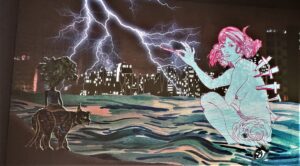
Natalia Di Pietranto, the new Assistant Curator of South Asian Art at the Seattle Art Museum explains her first exhibition “Embodied Change, Asian Art Across Time” as follows
“I wanted to . . . explore how the body is a site of both personal intimacy and possibility for change. . . I hope that visitors come away with a sense of how these artists are boldly imagining personal, political, and social change.”
The selection of artists covers a vast time span from the Indus Valley/Harappan era ( 3rd century BCE to 2nd Century CE) to the present moment. And in the first gallery, we see that time frame immediately, juxtaposed by the artist Chitra Ganesh, who selected early female goddess figures to be shown with her 2022 video Before the War. She is celebrating the transformation of historical goddesses into contemporary questing women in her video
(see top of post and below), drawn from comic books she read as a child on Hinduism.
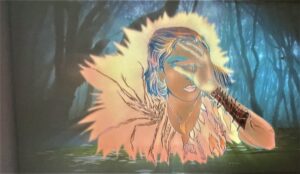
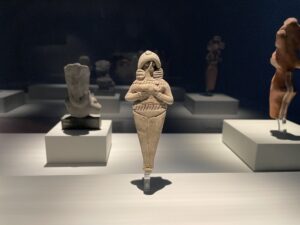
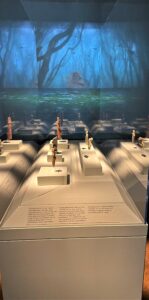
In the next gallery, a startling series of works includes Humaira Abid’s wonderful carved wood sculpture with a political punch. Here you see a suitcase made of wood with two shirts, a skull cap and prayer beads, as for a religious traveler. Beside it is a gun. The piece is called Sacred Games. The gun sits there silently, unrelated to the peaceful suitcase and yet awaiting our own interpretations and anxieties.

In this gallery are F.N. Souza’s Self Portraits and Adeela Suleiman’s amusing helmet that includes a tiffin (lunch) box.
The Pakistani artist Nazia Khan has a Cage-corset, 2007 corset as well as photos of a performance in which she wears various corset like garments.
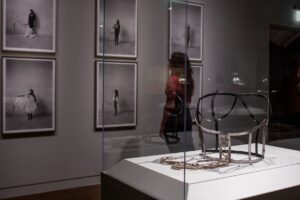 y
y 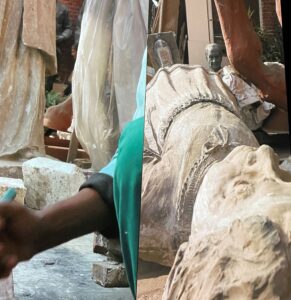
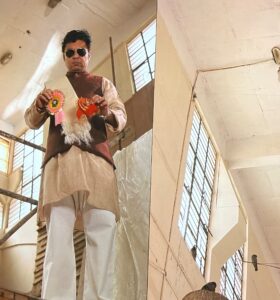
I loved the video by Bani Abidi Death at a Thirty Degree Angle. It gives us the art studio of a long time maker of commemorative statues, here filled with various stages of creation. In struts a local politician ready for his statue. As he poses with arms thrust up ( and talks on his cell phone at the same time), a local artisan sketches his outline, and other workers are creating other sculptures. Here we see the politician trying out various badges for his outfit. The artist uses split screens to enhance the off balance and humor as well as the skill of the artist himself.
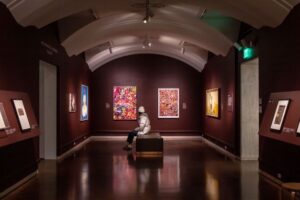
In the third gallery of the exhibition are familiar contemporary artists such as Rekha Rodwittiya
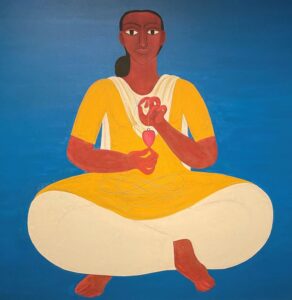
N. Pushpamala’s Motherland – The Festive Tableau, from the
Mother India project, 2009. Both Rekha and N. Pushpamela are redefining the historic goddess into contemporary women. In the case of Rekha she gives us an ordinary woman sitting with a powerful presence. In the case of Pushpamela she sends up the kitsch images of Mother goddesses in a hilarious historical recreation.
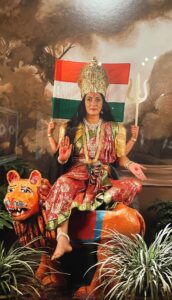
Mithila images by Jagadamba Devi of the the serpent goddess Naga Kanya suggest an entirely different perspective, more traditional as she is surrounded by her long serpent tail, but also very much in her own environment.
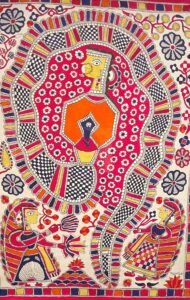
The quintessentially Indian Goddesses win out in the end with this gallery that spans tiny historical miniatures of dramatic scenes in which Durga takes on warriors and wins ( which were not allowed to be photographed). The contemporary artists images descend directly from those goddesses.
Outside the exhibition a scary neon Kali by Chila Kumari
Burman on the wall glows brightly 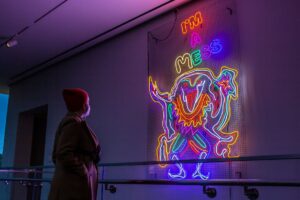
But the curator chose this image by Mithu Sen Miss Macho (Self Portrait), 2007 as the representative work for the exhibition.
Clearly a contemporary image of a trans woman, who looks out at us with her bold and beautiful eyes. By choosing this work the curator tells us that all that is new is old, and all that is old is still current in South Asian art. The concept of embodiment, of fluid gender, of powerful women has been around for a long time there, as well as all the social constructs that contradict that fluidity. While women in India may cover their heads with saris, they are some of the most powerful women I know. They still have Kali and Durga running in their veins.
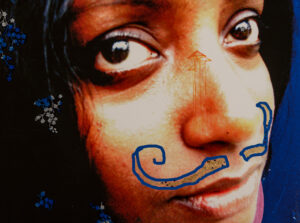
Asian Art Museum open 10-5 Fri – Sun
This entry was posted on March 26, 2022 and is filed under Art and Activism, Art and Politics Now, art criticism, Feminism, Uncategorized.








